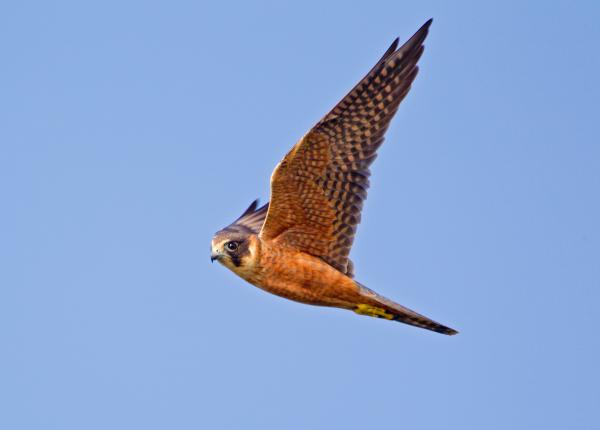How The Peregrine Fund is Helping
Though The Peregrine Fund doesn't work directly with the Australian Hobby, our efforts in scientific research, habitat conservation, education, and community development help conserve raptors on a global scale. We also supply literature to researchers from our avian research library, which helps scientists around the world gather and share important information on raptor conservation. Our support of the Global Raptor Information Network gives raptor researchers tools to more efficiently conduct their own studies while contributing to a global program. It also provides citizen scientists a way to participate in raptor science and conservation.
Where They Live
This species inhabits open forests, woodlands, savannas farmlands, and even wooded urban areas in parts of Australia, Lesser Sundas, New Guinea, New Britian, and Molucca Islands.
What They Do
These raptors are often crepuscular (hunting before dawk or at dusk) and sometimes even nocturnal, using artificial light sources that attract prey to find a tasty meal.
Why They Need Our Help
The Australian Hobby is categorized as Least Concern. It is fairly common in most portions of its range, and the population is probably stable. This species has likely benefited from the introduction of prey species in some parts of Australia. In the past, it suffered from DDE-induced eggshell thinning prior to the ban on DDT use, and may have suffered local declines in breeding success in the south. It is seldom shot.
What They Eat
The Australian Hobby feeds on a number of different prey items, including small birds, such as larks, sparrows, swallows, doves, and small parrots, among others. But their diet doesn't stop at birds. They will also feed on bats, flying insects and beetles. When on the hunt, these falcons might fly low and fast in search of prey, or sit on an exposed perched, waiting for prey to pass by. They often trap prey in flight - making dashing flights at about treetop level, frequently changing direction, and doggedly pursuing any birds it may flush. They will eat small prey, such as insects, on the wing.
Nests, Eggs, and Young
Like most falcons, this species doesn't build its own nest. Instead, they use old stick nests built by other species, typically Corvus. They also can nest in tree hollows. When the time is right, the female will lay 2–4 eggs. Incubation usually lasts from 28–35 days. After hatching, the young will be covered in fluffy down. They will remain in the nest for about 34–38 days before flying for the first time. After the young leave the nest, they will remain in their parents' territory for around 6 weeks learning to hunt, avoid danger, and otherwise survive on their own.
Australian Hobby and the World Center for Birds of Prey
Though far away from the Australian Hobby's distribution, The World Center for Birds of Prey is a great place to visit to learn all about this and other raptors. The visitor center offers interactive displays, tours, interesting videos and a children's room with activities from coloring sheets to quizzes to costumes and a touch table - all available for the curious mind. We also have several different birds of prey on display year-around, including several falcon species such as Aplomado Falcon, American Kestrel, and Gyrfalcon. Knowledgeable staff and volunteers are on hand to answer any questions you may have about Brown Falcons or any other birds of prey.
Resources:
Debus, S. and G. M. Kirwan (2020). Australian Hobby (Falco longipennis), version 1.0. In Birds of the World (J. del Hoyo, A. Elliott, J. Sargatal, D. A. Christie, and E. de Juana, Editors). Cornell Lab of Ornithology, Ithaca, NY, USA. https://doi.org/10.2173/bow.aushob1.01
Global Raptor Information Network. 2023. Species account: Australian Hobby Falco longipennis. Downloaded from http://www.globalraptors.org on 15 Dec. 2023









